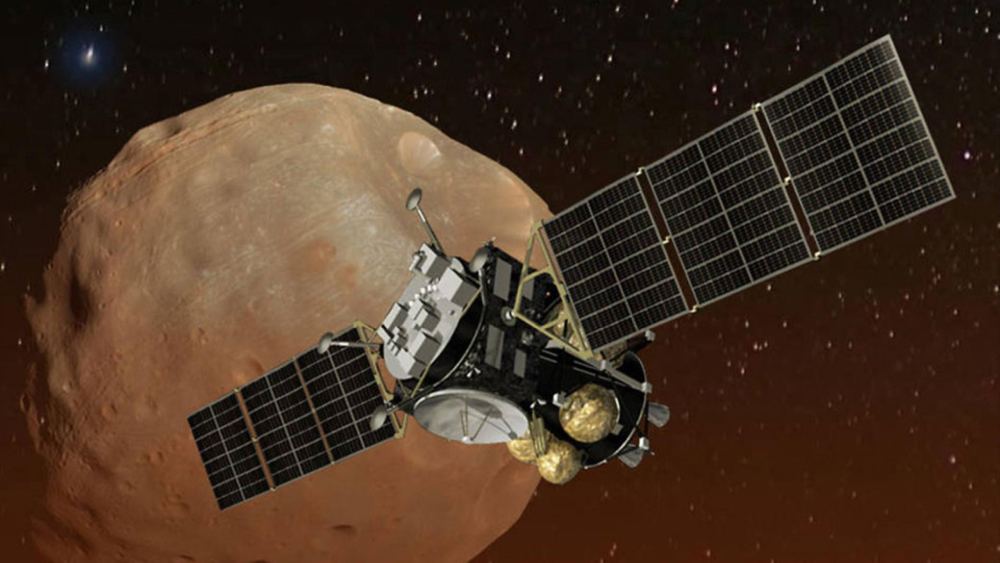JAXA, the Japanese Aerospace Exploration Agency, is carving out a niche for itself in sample-return missions. Their Hayabusa mission was the first mission to sample an asteroid when it brought dust from the asteroid Itokawa to Earth in 2010. Then its successor, Hayabusa 2, brought back a sample from asteroid Ryugu in 2020.
Now JAXA has the Martian moon Phobos in its sights and will send a spacecraft to sample it as soon as 2024. The mission is called Martian Moons eXploration (MMX), and it’ll use a pneumatic vacuum device to collect its samples.
Why go to Phobos and sample it? Because it’s an unusual moon and understanding it better could answer questions about it and our Solar System. And we always want more answers.
Phobos is the larger of Mars’ two moons, the other being Deimos. Both moons are irregularly shaped and look kind of like potatoes, especially Phobos. Phobos has a mean radius of only 11 km (7 mi). It’s closer to Mars than Deimos and orbits only 6,000 km (3,700 mi) from the planet’s surface. It moves rapidly, taking only 7 hours and 39 minutes to complete one orbit and completes three orbits each day.

Phobos is probably a captured rubble-pile asteroid, although astronomers still debate its nature. It has a lot in common with carbonaceous asteroids and is one of the least reflective objects in the Solar System.
The tiny moon is getting closer and closer to Mars. Every year it gets about 2 cm closer and will eventually be destroyed. In about 30 million to 50 million years, it will either smash into the surface of Mars and be utterly destroyed or be torn apart by tidal forces and form a debris ring around the planet. In fact, one hypothesis says that Mars’ moons were formed from dust created by a giant impact on Mars. Dust to dust, as they say.

Japan leads the MMX mission, but NASA, the CNES (France), and the DLR (Germany) are also contributing. It has two broad goals: (1) determining the origin of the Martian moons and (2) observing processes in the circumplanetary environment of Mars, based on remote sensing, in situ observations, and laboratory analyses of returned samples of Phobos regolith. Scientists think that a better understanding of the Mars-Phobos-Deimos system will shed light on the planetary formation process in the Solar System.
Getting a sample from Phobos faces several obstacles. The moon is not massive enough for a spacecraft to enter orbit around it in the usual way. Instead, MMX will enter orbit around Mars and then perform quasi-satellite orbits. Those orbits become unstable over time but should allow for several months of operation near Phobos. This maneuver also enables the MMX lander to reach Phobos’ surface.
JAXA designed the MMX mission with three components: a propulsion module, an exploration module, and the return module. The French CNES space agency suggested that the mission should also deploy a tiny rover about the size of a microwave to the surface, built by France and Germany.
But the highlight of the MMX mission will be the sample return. We’ve made enormous progress in sending instruments on spacecraft, landers, and rovers to examine Solar System bodies. When it comes to Mars, the in-situ study of the planet has unleashed a flood of new evidence and insights. But the holy grail in space missions is still sample return. No matter how advanced the instruments we send on missions are, lab analysis back on Earth will always outstrip them.
MMX will gather samples in two ways. One is the Coring Sampler (C-SMP) developed by JAXA. The other is the Pneumatic Sampler (P-SMP), contributed by NASA and developed by Honeybee Robotics.
The pair of samplers will complement each other and partially account for the fact that we don’t know what the surface is like. The Coring Sampler will be positioned on the lander’s robotic arm. It will use a special shape memory alloy to gather a 10-gram sample from deeper than 2 cm under the regolith.

The Pneumatic Sampler will be positioned near the footpad on one of the lander’s legs. It’ll use pressurized nitrogen gas to gather the samples, and mission operators can manipulate the gas flow depending on requirements. It can be either continuous or pulsed.

The P-SMP has three sets of nozzles to perform the procedure. Two excavation nozzles point downward, two retro thrust nozzles point upward, and two transport nozzles point toward the sampling tube. The three pairs of nozzles fire simultaneously.
The excavation nozzles fire at the surface of Phobos and stir up material from the regolith. The transport nozzles direct material into the sampling head. The retro thrust nozzles fire to counteract the thrust on the spacecraft, so its position is stable during sampling.
Honeybee Robotics has tested its P-SMP extensively and is confident that it can handle any surprises on Phobos’ surface. The company says its system can still gather a sample even if gravel covers the surface.
MMX won’t be the only mission to use Honeybee’s vacuum system. NASA plans to use it on the Moon to capture lunar regolith in Mare Crisium in 2023. The system is also being considered for a Europa Lander mission and several other missions still in the concept and design phase.
It’s easy to see why.
“The purpose of this technology is to allow simple and inexpensive capture of planetary materials from largely unknown surfaces,” said Honeybee project lead Kris Zacny. “Vacuum cleaners are designed to capture ‘dirt,’ hence a vacuum cleaner-like approach is ideal for working with planetary ‘dirt.'”
More:
- JAXA: MMX mission
- Lunar and Planetary Institute: Exploring the Origin of Mars’ Moons
- Universe Today: Evidence that Mars Used to Have a Ring

